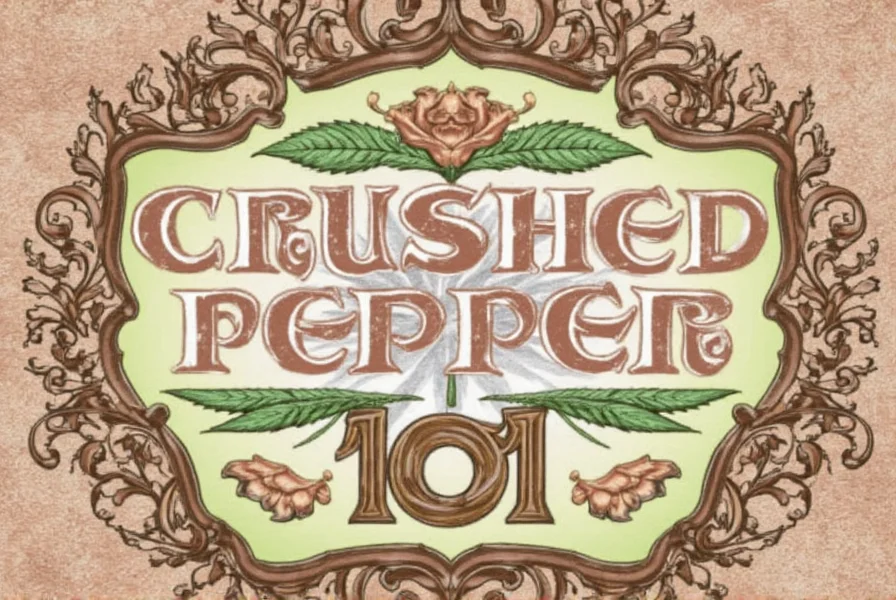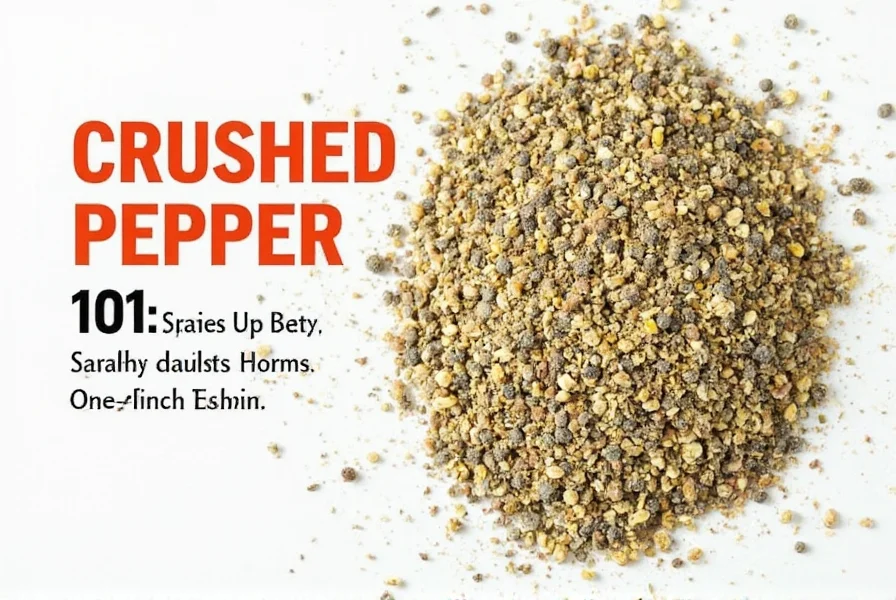- Top 10 Ways to Use Crushed Pepper in Your Kitchen
- What Exactly Is Crushed Pepper?
- Understanding Heat Levels: Scoville and Beyond
- Crushed Pepper vs. Flakes vs. Ground: What's the Difference?
- Buying Guide: How to Choose the Perfect Crushed Pepper
- Storage Tips: Keeping That Kick Alive
- FAQ: Your Crushed Pepper Questions Answered
Top 10 Ways to Use Crushed Pepper in Your Kitchen
Crushed pepper is a versatile spice that adds heat, depth, and complexity to countless dishes. Here are the top 10 ways to use it in your cooking:
- Pizza Power-Up: A sprinkle before baking adds instant zing.
- Spiced Butter: Mix into softened butter and slather over corn or steak.
- Marinade Magic: Add to dry rubs for grilled chicken or tofu.
- Egg Enhancer: Stir into scrambled eggs or avocado toast.
- Broth Boost: Toss into soups or stews for extra warmth.
- Oil Infusion: Infuse olive oil for homemade chili oil.
- Bread & Baking: Sprinkle over focaccia or add to biscuit dough.
- Dips & Sauces: Blend into hummus or ranch for a kick.
- Rice Revamp: Toss with cooked rice or stir into congee.
- Cocktail Rim: Combine with salt and rim your Bloody Mary glass!
What Exactly Is Crushed Pepper?
Crushed pepper refers to dried chili peppers that have been coarsely ground or broken into small pieces. Unlike finely ground cayenne or paprika, crushed pepper retains some texture and often includes bits of skin and seeds, which contribute to its overall flavor profile.
The most common type used is the red cayenne pepper, though varieties can range from mild ancho to fiery habanero. Some commercial blends even mix multiple types for a layered experience.
| Type of Pepper | Heat Level (SHU) | Flavor Notes |
|---|---|---|
| Ancho | 1,000–2,000 | Sweet, smoky, earthy |
| Cayenne | 30,000–50,000 | Sharp, bright, spicy |
| Habanero | 100,000–350,000 | Fruity, floral, intense |

Understanding Heat Levels: Scoville and Beyond
The Scoville scale measures the spiciness of peppers based on their capsaicin content. However, heat isn't everything—aroma, sweetness, bitterness, and aftertaste all play a role in how we perceive spice.
- Mild: Ancho, New Mexico
- Medium: Serrano, Anaheim
- Hot: Cayenne, Thai Bird's Eye
- Super Hot: Habanero, Ghost Pepper
Tip: If you want heat without the burn, opt for milder crushed peppers like ancho. They bring color and depth without setting your mouth on fire.
Crushed Pepper vs. Flakes vs. Ground: What's the Difference?
While they may look similar, these three forms of chili seasoning vary significantly in texture, intensity, and use cases.
| Form | Texture | Heat Intensity | Best For |
|---|---|---|---|
| Crushed Pepper | Coarse chunks | Moderate to high | Cooking, garnishing, infusions |
| Flakes | Small, flat pieces | High | Finishing, sauces, oils |
| Ground Chili | Fine powder | Very high | Dry rubs, blending into dough |
Buying Guide: How to Choose the Perfect Crushed Pepper
Not all crushed peppers are created equal. Here's how to pick one that suits your palate—and your pantry.
- Check Ingredients: Pure crushed pepper only—no fillers, anti-caking agents, or preservatives.
- Brand Spotlight: Brands like Penzeys, Simply Organic, and Frontier Co-op offer quality options.
- Whole vs. Pre-Crushed: Consider buying whole dried chilies if you prefer grinding your own.
- Organic vs. Conventional: Look for organic certifications if you're sensitive to pesticides.
- Packaging: Dark glass bottles help preserve flavor longer than plastic containers.
Top 3 Crushed Pepper Products Reviewed
| Product | Heat Level | Key Features | Best For |
|---|---|---|---|
| Penzeys Crushed Red Pepper | Moderate | Pure cayenne, no additives, bold color | Everyday cooking, pizza lovers |
| Simply Organic Crushed Red Chili | Medium-Hot | USDA Organic certified, fair trade | Health-conscious cooks |
| Frontier Co-op Whole Dried Chilies (to crush yourself) | Variety options | Natural oils retained, customizable grind | Home spice grinders, DIYers |

Storage Tips: Keeping That Kick Alive
Crushed pepper doesn't spoil easily, but it does lose potency over time. To keep it fresh:
- Store in a cool, dark place—away from heat sources like the stove.
- Use airtight containers to prevent moisture and oxygen exposure.
- Label your spices with purchase dates; aim to replace every 1–2 years.
Fun fact: Did you know you can refresh slightly stale crushed pepper by gently toasting it in a dry pan? Just don't walk away—this isn't microwave popcorn!
FAQ: Your Crushed Pepper Questions Answered
What's the difference between crushed pepper and red pepper flakes?
While often used interchangeably, there are subtle differences. Crushed pepper typically refers to coarsely broken dried chili pieces that may include seeds and membranes, while red pepper flakes are usually more uniformly sized, flatter pieces. Crushed pepper often has a more complex texture and can vary more in heat level depending on which parts of the pepper are included.
How spicy is crushed pepper compared to regular black pepper?
Crushed pepper (typically made from red chili peppers) is significantly hotter than black pepper. Black pepper registers around 10-100 Scoville Heat Units (SHU), while even mild crushed pepper like ancho ranges from 1,000-2,000 SHU. Cayenne-based crushed pepper can reach 30,000-50,000 SHU—making it dozens to hundreds of times hotter than black pepper.
Can I substitute crushed pepper for cayenne powder in recipes?
Yes, but with caution. Crushed pepper is generally milder than cayenne powder since it contains non-heat elements like skin and seeds. As a rule of thumb, use 1½ teaspoons of crushed pepper for every 1 teaspoon of cayenne powder. Remember that crushed pepper adds texture while cayenne dissolves completely, so consider the dish's final texture.
How long does crushed pepper stay fresh and potent?
Properly stored crushed pepper maintains peak flavor for 1-2 years. You'll notice it losing potency when the vibrant red color fades to a dull brick color and the aroma becomes less pronounced. While it won't spoil, its flavor and heat will diminish over time. For best results, replace your crushed pepper annually if used frequently.
Is crushed pepper the same as chili powder?
No, they're different products. Crushed pepper consists of actual pieces of dried chili peppers, while chili powder is a fine-ground blend that typically includes not just chilies but other spices like cumin, garlic powder, and oregano. Chili powder is generally milder and more complex in flavor, while crushed pepper delivers more direct heat and visual texture.
What are the health benefits of crushed pepper?
Crushed pepper contains capsaicin, which has been linked to several health benefits including metabolism boost, pain relief, and improved circulation. It's also rich in vitamins A and C, antioxidants, and may help reduce inflammation. The heat can stimulate digestion and appetite. However, benefits vary based on the pepper type and your individual tolerance.
Can I make my own crushed pepper at home?
Absolutely! Start with dried chili peppers (like cayenne, ancho, or guajillo), remove stems, and break into pieces. For coarse texture, pulse briefly in a food processor or use a mortar and pestle. For more control, crush by hand with a rolling pin. Homemade crushed pepper retains more essential oils and freshness but has a shorter shelf life—store in an airtight container away from light.
Why does my crushed pepper vary in heat between bottles?
Natural variations in pepper crops, growing conditions, and which parts of the pepper are included (seeds and membranes are hottest) cause inconsistency. Some brands blend multiple pepper varieties for consistency, while others may have seasonal variations. If consistent heat is important, choose a brand that specifically states their heat level or consider making your own blend from known pepper varieties.
Ready to Spice Things Up?
Try our favorite recipe using crushed pepper: Chili Oil Noodles with Sesame & Garlic. Coming soon!











 浙公网安备
33010002000092号
浙公网安备
33010002000092号 浙B2-20120091-4
浙B2-20120091-4